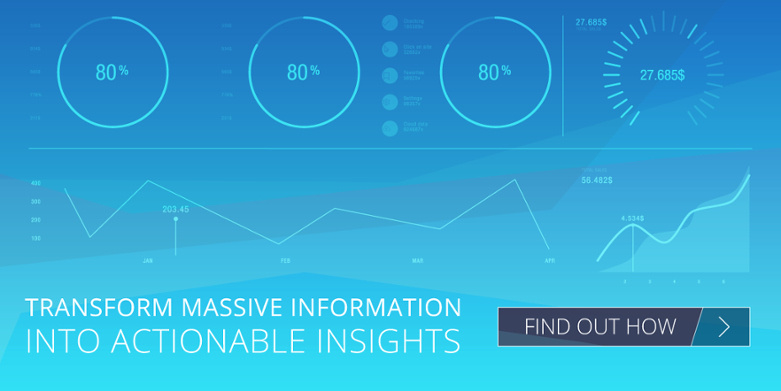
When people talk about digital customer data, the first thing that comes to mind for many marketers, is Google Analytics. It is a free tool that provides a whole lot of information. In fact, it provides so much information that it may be extremely overwhelming for most people. While many tend to look at the default dashboard on the analytics homepage and think the information given there is enough, the truth is, much of that data is pretty meaningless.
In fact, 59% of marketers rely on Total Lead Volume as a top metric and end up losing focus on the more important marketing data. 24% of marketers don't even know whether their efforts resulted in closed-won deals (when a lead turns into a potential customer and the sale is made), which is clearly a more important metric. For example, looking at closed-won data can tell you that 20% of your adwords traffic does convert, as opposed to only 10% of your Facebook ad traffic.
The most important thing for a business to put their focus on is which data is important to drive the success of their company forward. For example, in cases like an online magazine, traffic would be a key metric, while for an e-commerce site, less traffic with a higher conversion rate would be the key to focus on. (A great article to read regarding this is Beyond Traffic: How to Measure What Really Matters.)
According to research by BrightTALK, 42% of B2B marketing professionals state that a lack of quality data is their biggest barrier to lead generation. In addition, there are many different metrics to to consider, and making sense of them can be very difficult and confusing using Google Analytics. A great tool for consolidating your data, as well as cross referencing it into a clear, simple and easy to understand visual report, is Databox.
How to determine what data is the most important key to making sense of all the complex and complicated reports. It seems a bit confusing but let’s break it down into 3 easy to understand steps:
Step 1:
The first step is establishing what the most important digital marketing metrics actually are for your business. Once you know what the important metrics are, you can start to explore what effects those metrics have, and then you can come up with ways to improve them.
As stated above, not having quality data is the largest hurdle to lead generation. However, in many cases, it’s not the lack of data that is the problem, rather professionals are actually looking at the wrong data in order to reach meaningful conclusions.
There are 3 types of metrics that are important for your business, and you need to decide which of these specifically affect those metrics for your business.
Marketing - This is how to measure everything that brings the audience (client or prospect) to the point where they decide they want to enter the sales funnel. Depending on your type of business, it could mean they now talk to a salesperson (where there is a longer sales funnel) or in other types of businesses, it could mean clicking on “Buy Now” (where the sales “funnel” is one 10 second step).
Conversion - This is where you can see how good your site is at taking prospects and turning them into buyers. This includes conversion rates and cost per conversion. This step can also be viewed as “time on site” for non e-commerce sites, where engagement is what drives revenue. For example: a news site can raise the price of ad space if they show more engagement or “time on site”.
Business Metrics - This is where you will see the bigger picture. It is where you decide what the business model is and how you make money (your goal). Based on this, you decide what then needs to happen in order for you to get to your goal. This combines the two previous metrics, and lets you see what you spent on marketing, how much you are converting, what the average ticket is, and finally, how it all comes together to give you a better picture of your return on investment. This is also not necessarily looked at in a high level business view, but should be reviewed on a campaign basis so you know which campaigns are the best at driving the desired traffic to your site.
Step 2:
So you know what the most important metrics are, and you know what their values are. Now it is time for you to start setting your goals. Without goals there is no real way to measure your digital marketing success. As I previously mentioned, these goals will differ from business to business and industry to industry. These goals should be set while considering the various factors that will have an effect on your business.
For example, an office supply store setting goals for the month of September can not base their goals solely on x% more sales than what they have earned the previous month, because the previous month was “Back to School” and a seasonal peak in the business. They would need to base it on their past September sales and then set a goal on increasing that number. Another example would be a digital magazine. They can expect a lot more traffic to their political pages during the periods leading up to elections as opposed to non election years.
Step 3:
So now that we know WHAT to measure, and HOW to set the goals - it is time to set up a way to quickly and easily track your progress in order. You need to see if you are on track, and if you’re not, how to catch on quickly enough to make the correction before it becomes a serious problem. While Google Analytics does show a lot of data, tools such as Databox give you the ability to import data from numerous sources, cross reference them and then create a dashboard that will give you a holistic view of where your business stands at a glance.
You need to go through the process of sifting through which data is important or not and set your goals to track progress and package it all into an easy to read dashboard which will help show you exactly where you stand in the process, and where you need to be. Doing all this will make it a lot easier for you to be able to instantly see if you are on track to meet those goals. If you find that you’re not, you can easily enough see what the most effective activities are in order to get you back on the right path.
The other big advantage of working with a dashboard, is that it will give you the opportunity to see which data really matters and help you identify the data that does not.
Marketers that calculate ROI are 1.6 times more likely to receive higher budgetsLooking at some statistics show that this process really works.
- 40% of marketers say proving the ROI of their marketing activities is their top marketing challenge
- 72% of organizations that calculate ROI say that their marketing strategy is effective
Doing all this may sound like a lot of work, but the successful outcome is definitely worth it all. Take the time, do it right and reap the benefits.

by Perry Nalevka on January 09, 2018
CEO of Penguin Strategies






